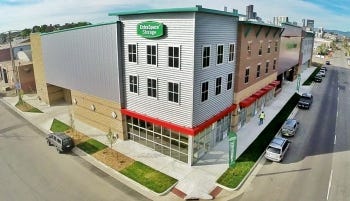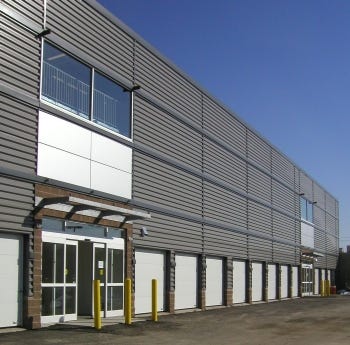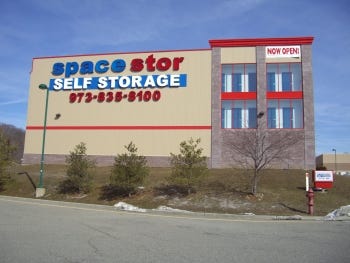Next-Gen Self-Storage: Innovation in Facility Development and Construction
New development and construction trends are emerging in the self-storage industry. Here’s a look at the innovations that are shaping the next generation of facilities.
August 9, 2015
By Katie Self
Following several years of light development in the self-storage industry, new projects are on the rise—literally. Once considered a staple, the sprawling, fortress-style facility is giving way to several-story designs as vacant land is gobbled up, parcel prices increase, and owners are forced to build on smaller lots.
But multi-story is just one trend emerging in modern self-storage construction. Developers, investors and owners are experimenting with contemporary styles, new materials and energy-efficient practices to shape the next generation of facilities. Overall, innovation is meeting consumer demand for better quality and more fashionable storage sites.
Building Height
As development trends go, multi-story leads the pack in self-storage. Builders have witnessed the growing appeal of constructing three or more stories vs. the expansive facilities of years past.
“The biggest trend that I have seen for 2015 is an increase in the number of facilities that are being constructed on smaller parcels of land and, therefore, going vertical,” says Charles Plunkett, president of Capco Steel Inc., a San Antonio, Texas-based supplier and erector of steel storage buildings. “This includes a movement toward upward construction in some burgeoning urban sprawls where revitalization projects have created an aesthetic appeal.”
Some metropolitan areas are seeing a tremendous boom in the addition of multiple levels to existing and newly constructed buildings, according to Rick Dodge, executive vice president at Paramount Metal Systems, a Rossville, Tenn., which specializes in self-storage design and construction. “Some older facilities are taking down existing buildings and coming back with multi-story buildings to increase their rent capabilities,” he says.
 That doesn’t mean drive-up, single-story building is completely out. Where space allows, it continues to prevail. Wider buildings with interior corridors are popular as a cost-effective way to maximize land use, says Steve Hajewski, marketing manager for Sun Prairie, Wis.-based Trachte Building Systems, which designs, manufactures and erects pre-engineered and customized steel self-storage systems.
That doesn’t mean drive-up, single-story building is completely out. Where space allows, it continues to prevail. Wider buildings with interior corridors are popular as a cost-effective way to maximize land use, says Steve Hajewski, marketing manager for Sun Prairie, Wis.-based Trachte Building Systems, which designs, manufactures and erects pre-engineered and customized steel self-storage systems.
 New Designs
New Designs

In addition to building height, architectural finishes are in vogue. Facility design has naturally evolved, as storage properties are sprinkled in among shopping malls and residential communities in many urban markets. This has led to a high-end look once reserved for office complexes. While it’s true that governing boards demand more aesthetically pleasing plans, self-storage owners and developers are reaping the benefits.
Corrugated materials with various patterns, lighting accents, and the use of color are just a few ways self-storage facilities have stepped out from the shadow of lackluster concrete fabrications into sleek architectural quarters. The modern design doesn’t stop at the curb, either. The rental office—the hub of a property—is getting a makeover as well.
“Self-storage is certainly becoming more retail, and a lot of owners realize that the customer’s final decision usually takes place in the office,” says Leeann Fleming, marketing manager for Janus International Group, a Temple, Ga., manufacturer of self-storage door and hallways. “Self-storage has seen a major transition from the early days of single-story, traditional drive-up units to climate- and temperature-controlled facilities offering numerous amenities like surveillance, heating and cooling, and a bright, clean appearance.”
Better Products
With the evolution of facility design comes new building materials and ways they can be used to improve the look and quality of storage structures. Wayne Woolsey, principal of Kiwi II Construction, a self-storage builder based in Murrieta, Calif., points to updates in methods and materials that have enhanced his recent projects. “We’re seeing higher use of insulated exterior-wall panels to achieve the new energy-code requirements. Plus, they’re a good, long-term maintenance item against stucco or exterior insulation and finishing systems.”
Builders are being more aggressive in the way they incorporate these new materials into self-storage design, Plunkett says, noting that the use of high-style roof lines, exposed steel, and specialized metal-paneling systems once traditionally used in other types of construction are entering the ring. Older construction stand-bys are being replaced with more effective products, adds Tarik Williams, vice president of TLW Construction Inc., a Gilbert, Ariz.-based general contractor specializing in self-storage. “Structural fiber strands are replacing rebar in concrete, which accelerates the pace of construction,” Williams says.
 Unsightly, outdated storage buildings are being replaced by more attractive counterparts. Thanks in part to fresh, contemporary design, industry owners and investors are benefitting from improved public perception. “These types of facilities change not only the way developers look at opportunities, but also change the way customers see the industry. Developers are finding new opportunities in more difficult areas, and customers see this as a mature industry,” Plunkett says.
Unsightly, outdated storage buildings are being replaced by more attractive counterparts. Thanks in part to fresh, contemporary design, industry owners and investors are benefitting from improved public perception. “These types of facilities change not only the way developers look at opportunities, but also change the way customers see the industry. Developers are finding new opportunities in more difficult areas, and customers see this as a mature industry,” Plunkett says.
Constructing an improved, sophisticated facility is typically a win for the community and the developer, says Hajewski. “We’re beginning to see a realization that not all storage is ugly. Storage renters have also spoken with their wallets. They’re typically willing to pay more to rent from a site that’s secure and attractive in appearance.”
Code Impact
Like all commercial buildings, modern self-storage facilities are also impacted by building codes, which might require the addition of firewalls, sprinklers or insulation. “The newest, biggest issue coming is the changes in the energy code. As the country adapts this new code, [the code is] going to have a large impact on the building cost,” says Dodge. Insulated wall panels are becoming more prevalent, and insulated roof panels are also working their way slowly into self-storage development.
Woolsey also believes the change in building, energy and fire codes could significantly dictate the path of upcoming construction and create related challenges. Plunkett agrees. “More owners will be forced to have more energy-efficient and environmentally friendly facilities as time goes on,” he says.
Transforming the Future
To glance at the future of self-storage building, you have to consider the big picture. While many of these development trends are rooted in urban areas, they may travel to outlying, rural markets. “We will see an aggressive return to new construction in self-storage as well as conversion or retrofit projects over the next few years,” Fleming says.
While the storage industry now enjoys national recognition as a desirable asset class, top-tier institutional and private-equity players perceive it as a prime investment, adding pressure to build better-looking properties. By expanding traditional techniques, adding innovative design and managing cost-effective methods, developers, investors and owners will not only create a new take on the industry, they’ll forge a path toward greater rewards in the years ahead.
Katie Self is studying journalism at Arizona State University’s Walter Cronkite School of Journalism and Mass Communication, with a focus on print. To reach her, e-mail [email protected].
You May Also Like





